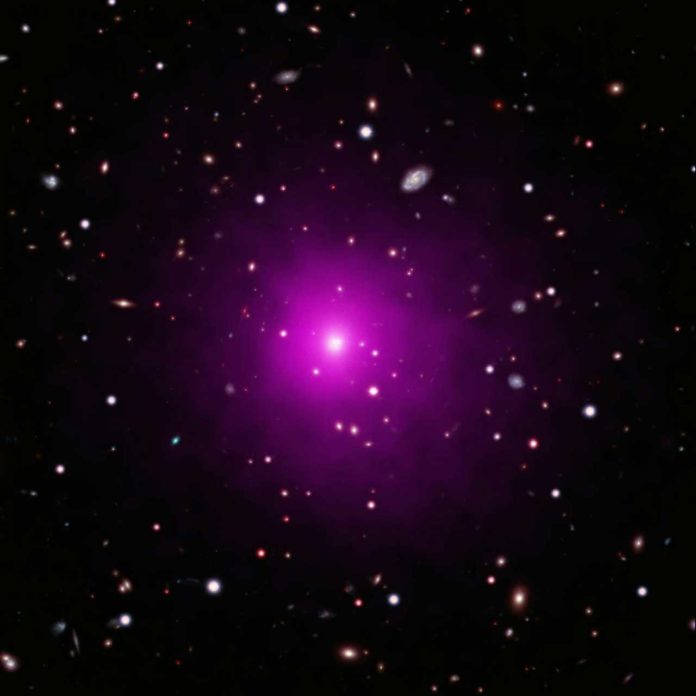Almost every galaxy has a supermassive black hole at its heart, with masses of millions to billions of times of the Sun.
Since the mass of a central black hole, for the most part, follows the mass of the galaxy itself, astronomers expect the galaxy in the center of Abell 2261 to contain a supermassive black hole that rivals the heft of probably the biggest known black holes in the Universe.
Using Chandra data obtained in 1999 and 2004, astronomers had already searched the center of Abell 2261’s large central galaxy for signs of a supermassive black hole. They took a gander at the material that becomes superheated when it fell towards the black hole and produced X-rays but did not detect such a source.
Despite searching with NASA’s Chandra X-ray Observatory and Hubble Space Telescope, astronomers have no evidence that a distant black hole is anywhere to be found.
Longer Chandra observations obtained in 2018 conducted a more in-depth search for the black hole in the center of the galaxy. They also considered an alternative explanation, in which the black hole was ejected from the host galaxy’s center. This violent event may have resulted from two galaxies merging to form the observed galaxy, accompanied by the central black hole in each galaxy merging to form one enormous black hole.
When black holes merge, the single hole settles down to a stable form, via a stage called ringdown, where any distortion in shape is dissipated as more gravitational waves. If these gravitational waves are stronger in one direction than another, the new, considerably more massive black hole would have been sent reeling away from the center of the galaxy in the opposite direction. This is known as a recoiling black hole.
Though, there is no definitive evidence for recoiling black holes. Also, it is unknown whether supermassive black holes merge and produce gravitational waves. So far, what astronomers have only verified that the mergers of much smaller black holes.
The galaxy at the center of Abell 2261 is the best region to search for a recoiling black hole. Why? Because two indirect signs suggest a merger has taken place. First, data from the Hubble and Subaru optical observations reveal a galactic core — the central region where the number of stars in the galaxy in a given patch of the galaxy is at or close to the maximum value — that is, much larger than expected for a galaxy of its size. The second sign is that the densest concentration of stars in the galaxy is over 2,000 light-years away from the galaxy’s center, strikingly distant.
Marc Postman from Space Telescope Science Institute (STScI) and collaborators identified these features in their earlier Hubble and Subaru images. The data helped them suggests the idea of a merged black hole in Abell 2261.
A supermassive black hole sinks towards the center of the newly coalesced galaxy during a merger. If they become bound to each other by gravity and their orbit begins to shrink, the black holes are expected to interact with surrounding stars and eject them from the center of the galaxy. This would explain Abell 2261’s large core.
Despite having the clues, neither Chandra nor Hubble’s data showed evidence for the black hole’s presence. Astronomers also study three clumps near the center of the galaxy and examined whether stars’ motions in these clumps are high enough to suggest they contain a ten billion solar mass black hole. No clear evidence for a black hole was found in two of the clumps, and the stars in the other one were too faint to produce useful conclusions.
While studying previous observations, they detected radio emissions near the center of the galaxy. That indicated that supermassive black hole activity had occurred there 50 million years ago but does not suggest that the center of the galaxy currently contains such a black hole.
Next, they turned to Chandra; they found that the densest hot gas was not in the center of the galaxy. They did not reveal any possible X-ray signatures of a growing supermassive black hole — no X-ray source was found in the center of the cluster, or any of the clumps of stars, or at the site of the radio emission.
Based on that, astronomers noted, “either there is no black hole at any of these locations, or that it is pulling material in too slowly to produce a detectable X-ray signal.”
The mystery of this gigantic black hole’s location, therefore, continues.
Journal Reference:
- Kayhan Gultekin et al. Chandra Observations of Abell 2261 Brightest Cluster Galaxy, a Candidate Host to a Recoiling Black Hole. arXiv:2010.13980
